Embarking on your yoga journey can be an exciting step towards enhancing your well-being. If you’re new to yoga, it might seem intimidating, but it’s more accessible than you think! Every yoga practitioner starts somewhere, and mastering a few fundamental poses is the perfect launchpad. This guide introduces five beginner-friendly yoga poses, including the cat pose and downward dog, to help you build a solid foundation in your practice from the comfort of your home. Discover how these postures, including variations and modifications, can improve your flexibility, strength, and overall balance.
1. Downward-Facing Dog (Adho Mukha Svanasana)
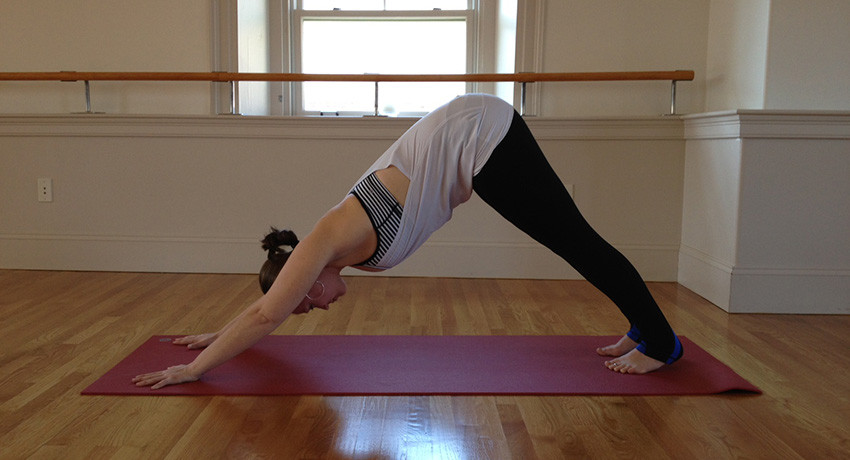 Stacey Allaire demonstrating downward dog yoga pose. Person in downward dog pose on yoga mat.
Stacey Allaire demonstrating downward dog yoga pose. Person in downward dog pose on yoga mat.
Downward Dog is an iconic yoga pose, recognizable even to those unfamiliar with yoga. It’s a fantastic full-body stretch that gently strengthens your arms, shoulders, and legs while lengthening your spine and hamstrings. When practiced with proper alignment, Downward Dog can be incredibly rejuvenating and calming.
How to perform Downward Dog:
- Begin on your hands and knees, ensuring your wrists are directly under your shoulders and knees are under your hips. Spread your fingers wide for a stable base.
- Tuck your toes under and lift your hips up and back, forming an inverted V-shape with your body.
- Engage your core and lengthen your spine, aiming to create a straight line from your wrists to your hips.
- Allow your head to hang freely, relaxing your neck. Gaze gently towards your feet or knees.
- Press firmly into your hands and feet, distributing your weight evenly.
- You may keep a slight bend in your knees initially, focusing on lengthening your spine. As flexibility increases, you can work towards straightening your legs and lowering your heels towards the floor, though it’s not necessary for heels to touch the ground.
- Hold the pose for 5-10 breaths, breathing deeply and evenly.
- To release, gently lower your knees back to the floor and return to a tabletop position or rest in child’s pose.
Benefits of Downward Dog:
- Strengthens arms, shoulders, and legs
- Lengthens the spine, hamstrings, and calves
- Calms the brain and helps relieve stress and mild depression
- Energizes the body
- Improves digestion
2. Cat-Cow Pose (Marjaryasana to Bitilasana)
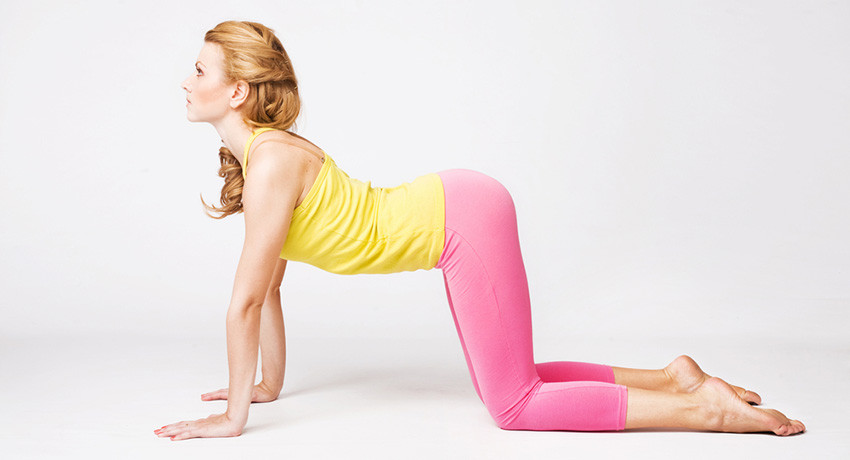 Series of images depicting the cat cow yoga pose flow. Two images showing cat and cow pose transition.
Series of images depicting the cat cow yoga pose flow. Two images showing cat and cow pose transition.
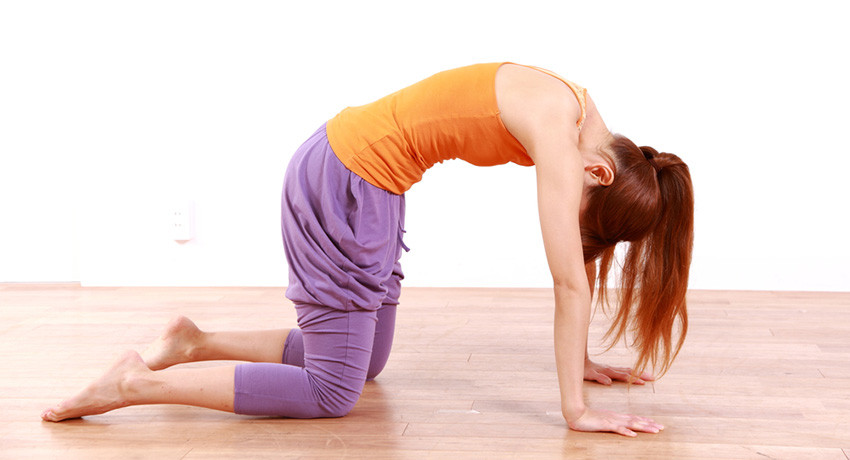 Image of a woman demonstrating cat cow pose on a yoga mat. Woman performing cat and cow yoga poses.
Image of a woman demonstrating cat cow pose on a yoga mat. Woman performing cat and cow yoga poses.
Cat-Cow is a dynamic duo of poses often linked together to warm up the body and increase spinal flexibility. Moving between Cat and Cow pose creates a gentle flow that massages the abdominal organs and promotes emotional balance. It’s an excellent way to start your yoga practice or to alleviate back stiffness.
How to perform Cat-Cow Pose:
- Begin in a tabletop position, with wrists under shoulders and knees under hips. Ensure your weight is evenly distributed.
- Cow Pose (Bitilasana): Inhale as you drop your belly towards the mat. Lift your tailbone and chest towards the ceiling, creating a gentle curve in your lower back. Draw your shoulders away from your ears and allow your gaze to gently lift upwards.
- Cat Pose (Marjaryasana): Exhale as you round your spine towards the ceiling, tucking your tailbone and drawing your pubic bone forward. Release your head towards the floor, but don’t force your chin to your chest. Imagine drawing your navel up towards your spine.
- Continue flowing between Cat and Cow poses for 5-10 rounds, synchronizing your breath with your movement. Inhale for Cow, Exhale for Cat.
- After completing the desired rounds, return to a neutral tabletop position.
Benefits of Cat-Cow Pose:
- Increases spinal flexibility and mobility
- Stretches the hips, abdomen, and back
- Stimulates digestive organs
- Promotes balance and emotional release
- Relieves stress and calms the mind
3. Mountain Pose (Tadasana)
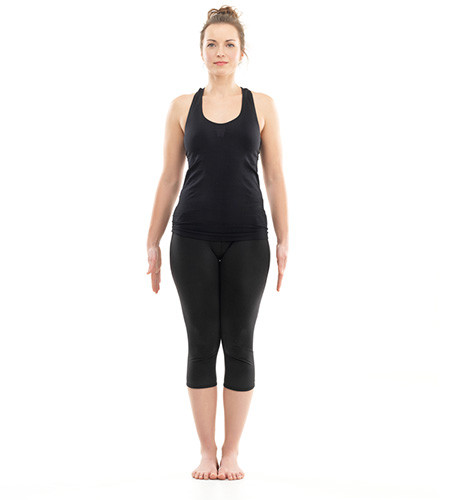 Woman standing in mountain pose on a yoga mat in a studio. Woman in mountain pose demonstrating proper posture.
Woman standing in mountain pose on a yoga mat in a studio. Woman in mountain pose demonstrating proper posture.
Mountain Pose might seem like just standing, but it’s the foundation for all standing poses in yoga. It teaches you proper posture, grounding, and body awareness. Engaging various muscle groups from your feet to the crown of your head, Mountain Pose cultivates strength and stability.
How to perform Mountain Pose:
- Stand with your feet together or hip-width apart, ensuring they are parallel.
- Distribute your weight evenly across both feet. Feel the four corners of your feet (heel, base of big toe, base of little toe) grounding into the mat.
- Engage your leg muscles, lifting your kneecaps and drawing your thighs up.
- Tuck your tailbone slightly and engage your core muscles to support your lower back.
- Relax your shoulders down and back, allowing your arms to hang naturally at your sides with palms facing forward.
- Lengthen your spine and reach the crown of your head towards the ceiling, as if a string is gently pulling you upwards.
- Keep your gaze soft and focused straight ahead, or gently close your eyes to enhance inner awareness.
- Hold the pose for several breaths, maintaining engagement and awareness throughout your body.
Benefits of Mountain Pose:
- Improves posture and balance
- Strengthens thighs, knees, and ankles
- Firms abdomen and buttocks
- Increases awareness and mindfulness
- Grounding and stabilizing pose
4. Tree Pose (Vrksasana)
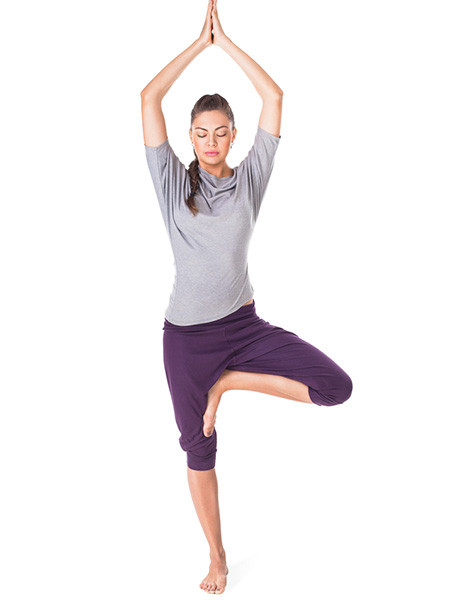 Person balancing in tree pose during yoga practice. Woman demonstrating tree pose for balance.
Person balancing in tree pose during yoga practice. Woman demonstrating tree pose for balance.
Tree Pose is a balancing posture that enhances focus and stability, both physically and mentally. It strengthens your legs, ankles, and core while promoting a sense of calm and centeredness. It’s a great pose to challenge your balance and improve concentration.
How to perform Tree Pose:
- Begin in Mountain Pose.
- Shift your weight onto your left foot, grounding down firmly.
- Bend your right knee and place the sole of your right foot on your inner left thigh, calf, or ankle. Avoid placing your foot directly on your knee joint.
- Press your right foot into your inner left thigh (or calf/ankle) and your left leg back against your foot. Find your balance and center.
- Bring your hands to prayer position at your chest center (Anjali Mudra).
- For a greater challenge, you can extend your arms overhead, palms facing each other or slightly apart.
- Maintain your gaze on a fixed, non-moving point in front of you to aid balance.
- Hold the pose for 5-10 breaths.
- Gently release back to Mountain Pose and repeat on the opposite side.
Benefits of Tree Pose:
- Improves balance and stability
- Strengthens thighs, calves, ankles, and spine
- Stretches the groins, inner and outer thighs, chest and shoulders
- Enhances concentration and mental focus
- Calming and grounding pose
5. Upward-Facing Dog (Urdhva Mukha Svanasana)
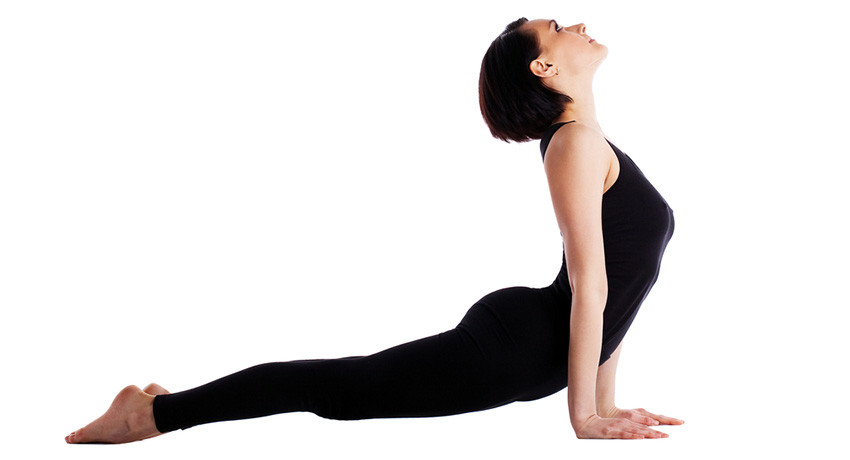 Yoga instructor demonstrating upward facing dog pose. Person in upward dog pose stretching back.
Yoga instructor demonstrating upward facing dog pose. Person in upward dog pose stretching back.
Upward-Facing Dog is a backbending pose that opens the chest, strengthens the spine and arms, and stretches the abdomen and hip flexors. It is often part of the Sun Salutation sequence and is a powerful pose for energizing the body and counteracting the effects of prolonged sitting.
How to perform Upward-Facing Dog:
- Lie face down on your mat with your legs extended behind you and the tops of your feet pressing into the floor.
- Place your hands palms down on the floor beside your ribcage, with your fingers pointing forward. Keep your elbows tucked in close to your body.
- Inhale deeply and press firmly into your hands and the tops of your feet.
- Straighten your arms and lift your chest and thighs off the floor. Only your hands and the tops of your feet should be touching the mat.
- Keep your thighs and buttocks firm but not clenched. Rotate your thighs slightly inward.
- Draw your shoulders back and down, opening your chest and heart center forward.
- Keep your gaze straight ahead or gently tilt your head back, avoiding straining your neck.
- Hold the pose for 1-2 breaths, breathing smoothly.
- To release, exhale and slowly lower your body back down to the mat.
Benefits of Upward-Facing Dog:
- Strengthens spine, arms, and wrists
- Stretches chest, abdomen, and hip flexors
- Stimulates organs of abdomen
- Improves posture
- Energizing and uplifting
These five poses—Downward Dog, Cat-Cow, Mountain Pose, Tree Pose, and Upward-Facing Dog—provide a wonderful starting point for your yoga practice. By regularly practicing these foundational poses, you’ll build strength, flexibility, and body awareness, setting the stage for exploring more advanced yoga postures and deeper benefits. Remember to listen to your body, breathe deeply, and enjoy the journey of yoga!

